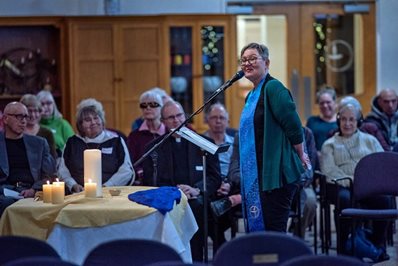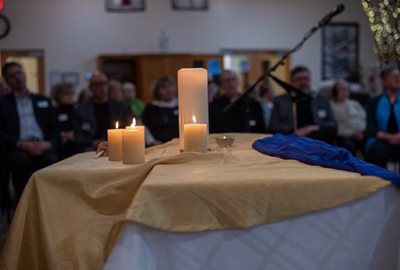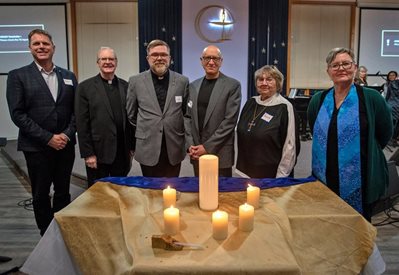It was a powerful evening. Sure, there are all kinds of significant differences between the congregations represented at that vigil. But everyone believed that making a united statement for peace was important.
The church we go to is on a downtown street. The street was mostly built around 100 years ago. And so there are lots of churches.
When we walk to church, we pass the United church, the Canadian Reformed church, and the Catholic church, before we reach our own Anglican church. If we were to turn a little to our right at that point, we’d very quickly get to the Presbyterian church. If we go on past our church, we’d come to the Unitarian church, housed in a building that used to be a big hardware store.
 That’s a lot of churches. In the 27 years we’ve lived in this downtown area, I can’t remember any occasions when all six of those churches have done anything together. In fact we rejoice when two or three get together, for any cause. Which at least seems scriptural.
That’s a lot of churches. In the 27 years we’ve lived in this downtown area, I can’t remember any occasions when all six of those churches have done anything together. In fact we rejoice when two or three get together, for any cause. Which at least seems scriptural.
But something happened last month. The situation in Israel and Palestine is so dire and so appalling that some of the Christians on the street were feeling that we really have to be concerted in prayer. So a group started planning and preparing for a prayer vigil. And they managed to get all six of those churches involved.
They thought about inviting the local Jewish synagogue and the local Muslim mosque to join too. But in the end they felt that, given the intense volatility and highly divisive feelings around the whole issue of the war in Gaza, this might just be too difficult, too likely to create a place for the expression of anger rather than peace.
 My husband and I attended the prayer vigil. It was simple. There were no homilies or sermons or manifestos. There was music, and there were prayers, and there was silence. The music was led by a Catholic pianist, a Presbyterian viola-player, and an Anglican singer. Halfway through the vigil we sang a Taize chorus about love. The ministers of each of the churches in our immediate neighbourhood led the congregation in prayer.
My husband and I attended the prayer vigil. It was simple. There were no homilies or sermons or manifestos. There was music, and there were prayers, and there was silence. The music was led by a Catholic pianist, a Presbyterian viola-player, and an Anglican singer. Halfway through the vigil we sang a Taize chorus about love. The ministers of each of the churches in our immediate neighbourhood led the congregation in prayer.
The minister from the Unitarian church, in whose building we were meeting because the space was the easiest to use on such an occasion, welcomed us and led us in a prayer of invocation.
The Canadian Reformed pastor led us in a prayer of lament.
The Anglican priest led us in a prayer of confession.
The Presbyterian minister led us in a prayer of intercession.
The Catholic priest led us in a prayer for peace, from Pope Francis.
The United Church minister led us in a prayer of benediction.
After each prayer there was time for silent reflection.
And that was it.
Except that, in her final words of leave-taking, the Unitarian minister made a point of welcoming a local rabbi, whom she had noticed sitting quietly to the side of the congregation.
It was a powerful evening. Sure, there are all kinds of significant differences between the congregations represented at that vigil. I suspect the preparatory meetings between the ministers were not always easy or straightforward. But what happened that evening was vitally important. Everyone saw that the situation in Gaza is catastrophic. Everyone believed that making a united statement for peace was important. And perhaps everyone also understood that the one Person who can really hear the cries of our hearts is our Lord God, who calls us to peace. If we can’t answer that call even on our own peaceful street, how can we expect it to be answered in the crisis-ridden places of the world?
Deborah Bowen attends St John the Evangelist Anglican Church in Hamilton, Ont. Photo of hands mural from Newberg, Oregon, by George Fox University students, offered freely by photographer Tim Mossholder on Unsplash. Event photos by Tim McKenna used with permission.